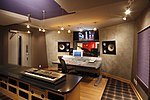Eugene O'Neill Theatre

The Eugene O'Neill Theatre, previously the Forrest Theatre and the Coronet Theatre, is a Broadway theater at 230 West 49th Street in the Theater District of Midtown Manhattan in New York City. The theater was designed by Herbert J. Krapp and was constructed for the Shubert brothers. It opened in 1925 as part of a hotel and theater complex named after 19th-century tragedian Edwin Forrest. The modern theater, named in honor of American playwright Eugene O'Neill, has 1,108 seats across two levels and is operated by Jujamcyn Theaters. The auditorium interior is a New York City designated landmark. The facade was originally made of brick and terracotta to complement the neighboring hotel. The original facade was removed in a 1940s renovation and replaced with stucco; the modern theater is of painted limestone and contains a large iron balcony. The auditorium contains Adam-style detailing, a large balcony, and box seats within decorative arches. There is also a five-centered proscenium arch and a coved ceiling with medallions. The Shuberts developed the Forrest Theatre after World War I as part of a theatrical complex around 48th and 49th Streets. When the Forrest Theatre opened on November 24, 1925, its first production was the musical Mayflowers. After a series of unsuccessful shows, the Shuberts lost the theater to foreclosure in 1934, upon which it hosted Tobacco Road, which became the longest-running production in Broadway history. Following a brief run as a broadcast studio in 1944, the theater was sold in 1945 to City Playhouse Theatres, which renovated the theater and renamed it the Coronet. The theater was sold in 1959 to Lester Osterman, who renamed it after Eugene O'Neill. The playwright Neil Simon acquired the theater in 1967, after which he staged several of his own works there. Jujamcyn has operated the theater since 1982 and restored it in 1994. The O'Neill has hosted the musical The Book of Mormon since 2011.
Excerpt from the Wikipedia article Eugene O'Neill Theatre (License: CC BY-SA 3.0, Authors, Images).Eugene O'Neill Theatre
West 49th Street, New York Manhattan
Geographical coordinates (GPS) Address External links Nearby Places Show on map
Geographical coordinates (GPS)
| Latitude | Longitude |
|---|---|
| N 40.761111111111 ° | E -73.985833333333 ° |
Address
Eugene O'Neill Theatre
West 49th Street 230
10019 New York, Manhattan
New York, United States
Open on Google Maps










